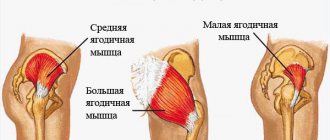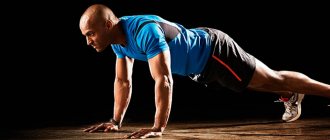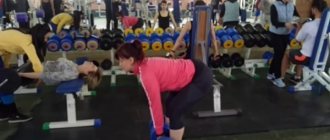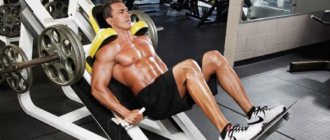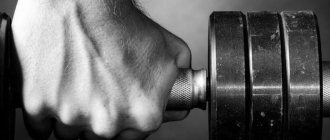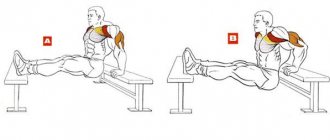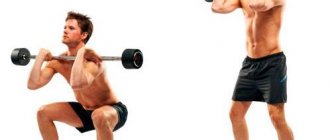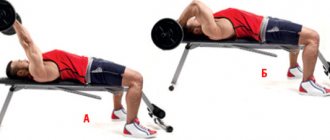The simplest, most accessible and at the same time effective exercises are squats with dumbbells, which can be performed at home and in the gym. They have a wide range of benefits, helping to lose weight and achieve beautiful definition. It is important to know and follow the details of the execution technique.
The benefits of squats with dumbbells
To make sure that squats should be included in your workout, you need to look at their benefits:
- The muscles of the buttocks and thighs are well worked out, which makes the figure more attractive. For those who want to lose weight, you should know that squats help fight excess fat by increasing muscle mass.
- Many people are interested in whether squats with dumbbells are effective for muscle growth, so with regular exercise and constantly increasing the load, you can achieve good results. When performed correctly, it stimulates the production of hormones (testosterone and growth hormone), which is important for building muscle tissue.
- Doing squats with dumbbells can improve your overall health. Exercise can reduce the risk of injury by strengthening muscles and improving flexibility.
- If you squat with dumbbells, you can significantly improve your athletic performance. This exercise is used in the training of almost all athletes.
- Regular exercise strengthens your back, which helps improve your posture. Squats have been proven to help relieve back pain. It is important to stick to proper technique and not try to use too much weight.
Squats with dumbbells - what muscles work?
The presented exercise is aimed at working out the lower part of the body, so during training the leg muscles work hard. Classic squats with dumbbells place a greater load on the gluteus maximus, quadriceps and hamstrings, as well as the adductor muscles of the thighs and calf muscles. In addition, during a squat, the muscles of the shoulders and stabilizers (arms, abdomen and back) are involved in the work.
Will training at home be effective?
The gluteal muscles are used in many everyday movements. But in order for the butt to gain elasticity, special classes are needed. Of course, exercise machines and equipment in the gym will help you quickly pump up your buttocks, but training is quite possible at home.
The main thing is not to spare yourself, and to get ready to work in a home atmosphere, which is often difficult. After exercise, the muscles should “burn.” Regular squats, plies and other exercises do not require machines. The problem may arise in the weights. The cost of sports equipment is considerable, but for training it will be enough to buy a pair of dumbbells, which are affordable.
Squats with dumbbells - types
There are different types of this exercise, which differ in the position of the legs and arms. You should start with the classic version, since it is the basis for all options. There is a certain scheme for how to squat with dumbbells:
- Stand up straight with your back straight and your heels flat on the floor. The body weight should be shifted to the feet.
- Dumbbells should be in your hands. When performing a squat, move your pelvis back slightly, as if sitting on a chair. Bend your knees until your thighs are parallel to the floor. As a result, at the moment of squatting, the dumbbells should be at a height just above the ankle.
- Keep in mind that breathing is important, so when going down, be sure to take a deep breath, and when going up, exhale.
- Slowly rise up, placing your hands on your hips. Do not straighten your knees all the way to maintain the load. Squats with dumbbells, the technique of which includes important nuances, should be performed with a slight delay at the top and bottom points.
Plie squats with dumbbells
To work out the inner thighs, it is recommended to include this exercise in the complex, which has its own characteristics:
- To train, hold one dumbbell with both hands. Keep your feet at a distance wider than your shoulders, the main thing is to be comfortable.
- The sumo squat with a dumbbell must be performed with your toes slightly turned out, about 45 degrees.
- Lower and rise, making sure that your knees do not meet and do not go over the balls of your feet. Keep your body upright without bending over.
Bulgarian squats with dumbbells
To perform this effective exercise, you need a bench or other platform that is approximately knee-high. By training each leg separately, you can thoroughly work out the muscles. Split squats with dumbbells are performed according to the following scheme:
- Stand with your back to the bench a short distance from it. Place one foot on the surface of the bench and move the other forward, about 20 degrees.
- Squat down slowly, making sure your thigh is parallel to the floor. When doing dumbbell glute squats, keep your torso straight and don't touch your back knee to the floor.
Squats with dumbbells on shoulders
The classic version of the exercises can be modified by changing the position of the hands, for example, holding dumbbells on the shoulders and partially on the chest. It is important to find the most comfortable position. There are several features of how to properly squat with dumbbells placed on your shoulders so that they do not roll down, you do not need to slouch and do not raise your elbows high. Make sure to keep your shoulders still. If the contact of dumbbells with your body is unpleasant, it is recommended to place something soft on your shoulders, such as a towel.
Squats with dumbbell up press
The basic version of the exercise can be varied to simultaneously train both the lower and upper body. As a result, in addition to the hips and buttocks, the biceps and shoulder muscles are involved in the work. Squats with dumbbells in hands are performed taking into account the following features:
- The starting position is identical to the classic version of the exercise. Place the dumbbells in your hands on your shoulders.
- After performing the squat, you need to squeeze the dumbbells up above your head. Please note that your hands should move in a straight path and not move.
How should a girl breathe correctly when squatting?
Squats are effective basic exercises that are included in many training complexes. They have a positive effect on many areas of the body:
- the joints of the legs are stretched
- improves blood circulation in the pelvic area
- the muscles of the back, abs, buttocks, calves are tightened
- the load on the heart muscle increases, thereby creating a healthy rhythm of its work
- the condition of the tendons improves
However, you need to understand that intense physical activity is a kind of stress for our body. And it requires more oxygen to distribute the necessary nutritional components evenly to all muscles and internal organs.
In order to get the expected effect from squats, you need to breathe properly while doing them. After all, the correct breathing rate is important for many aspects:
- increases endurance, allowing you to train with greater effort and number of approaches
- promotes uniform load distribution
- reduces the risk of injury from exercise
- helps achieve the desired results in a shorter period
Breathing during squats
There are two types of breathing:
- Chest - the chest is filled with air. Characteristic of a person in the absence of physical activity
- Abdominal (involving the diaphragm) – deeper, in which the abdominal cavity is involved. When filled with air, it expands the chest, and thereby allows the body to receive more oxygen.
When playing sports, professionals use diaphragmatic breathing, which is performed as follows:
- draw air through your nostrils
- try to direct the volume of air into the abdominal cavity, protruding your belly to its maximum size
- exhale smoothly and slowly, contracting your abdominal muscles
It is also important to remember that during any physical exercise, exhalations are carried out during the greatest load, and inhalation is carried out at the least. This is due to the peculiarities of the body's functioning: during inhalation:
during inhalation:
- chest stretches
- the abdominal muscles relax
- makes it difficult to experience severe muscle tension
during exhalation:
- muscles tense more
- Abdominal tension occurs and the body stabilizes
- The pectoral muscles are grouped, forming a kind of corset, which helps in developing the greatest strengthening
The maximum load during the squatting process occurs when returning to a standing position. This means that at the moment when you go down, inhale, and when you get up, exhale.
Breathing when squatting with a load
When performing squats, consider the recommendations for proper breathing from professional trainers:
standing in the starting position, exhale to rid the lungs of carbon dioxide, inhaling through your nose, start squatting. The lips should be compressed. Remember, you can only inhale through the nose, because in its mucous membrane there are receptors through which oxygen passes, signals are sent to the brain, as a result, the organs begin to work more intensely, having reached the lowest point, you can hold your breath for 1-2 seconds, exhaling, rise to starting position. Exhalation can be done through the mouth, slightly parting the lips (but without opening the mouth too wide) do not try to inhale more air, because this can lead to a rapid breathing rhythm, and oxygen will flow unevenly into the tissues; with a fast pace of exercise, breathing should be shallow and frequent , and with slow - measured and deep exhalations and deep inhalations, the load on the heart increases, and this can lead to dizziness and fainting, even with minimal breath holding, pressure increases, which can negatively affect well-being; it is allowed to exhale noisily when working with heavy weights ( pancake, barbell, dumbbell)
In other cases, it is recommended to exhale quietly; if possible, train in the fresh air or in a ventilated area; do not focus your attention solely on breathing. This process should be easy and natural, otherwise you risk losing control over your body, and the exercise will ultimately be performed incorrectly. Learn to control your breathing from the very first lessons in the gym or at home
This will help you develop the right habit.
Squats with dumbbells for weight loss
In order for body volume to decrease quickly, you need to properly create a training program. It is important to think through the days of classes and the number of repetitions in advance. To get results in a short time, it is recommended to add other exercises to your workout.
- A dumbbell squat program can include 3-4 sessions as the muscles need to recover.
- You should start with 50 repetitions, for example, dividing them into 5 sets of 10 times. Please note that the break between approaches should not be more than 5 minutes.
- Gradually increase the number of repetitions and decrease the time between sets.
Lunges
A very effective exercise that allows you to strengthen all the gluteal muscles, make your butt firm and pumped up. It is one of the most popular and favorite squats among the fair sex. Keep your back straight. Spread your legs, taking a small step forward. As you inhale, slowly lower yourself down until the leg pulled back completely falls to the floor. In this case, the leg extended forward should be at an angle of 90° relative to the floor. As you exhale, return to the starting position. Then repeat the exercise, changing legs.
Squats with dumbbells are harmful
Under some circumstances, an exercise can be dangerous and in most cases this is due to errors in execution technique. Beginners are advised to start training without additional load and it would be a good idea to first consult with a doctor to rule out possible health problems. Squats with dumbbells can hide the following danger:
- When performing an exercise incorrectly, your knees will be subject to severe stress, resulting in a significant increase in the risk of joint-related injuries.
- Increase the load gradually, as too heavy a weight can cause sprains.
- Squats with heavy dumbbells can cause back injuries, so it's important to make sure there are no spinal problems. Common mistakes are leaning forward too much and rounding your back.
